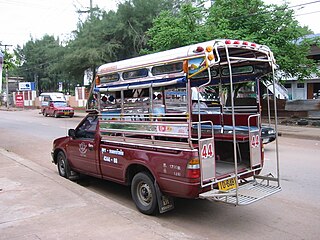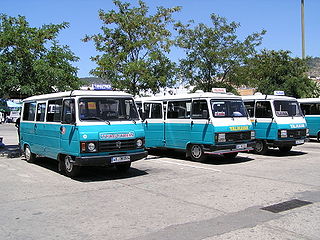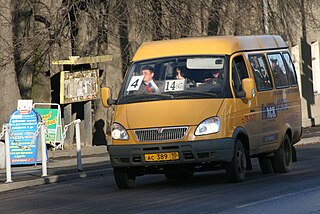
Novosibirsk Marshrutka is a fixed route taxi system in Novosibirsk. This type of transport began operating in the city in the 1970s. In the 2010s, the city authorities began to gradually replace minibuses with buses.

Novosibirsk Marshrutka is a fixed route taxi system in Novosibirsk. This type of transport began operating in the city in the 1970s. In the 2010s, the city authorities began to gradually replace minibuses with buses.
In the late 1970s, the first rout taxi minibuses (RAF-2203) appeared in Novosibirsk. During the Soviet period, the marshrutka network consisted of 13 routes which mainly went from metro stations to remote areas of the city. One of the first routes was introduced towards Akademgorodok (Sovetsky District). The minibus ride cost 15 kopecks. It was three times more expensive than tram or trolleybus rides, which cost 5 kopecks. [1]
All fixed-route taxis belonged to the city, namely, the Municipal Enterprise of Road Transportation No. 5 (PATP-5). [1]
In 1989, the first cooperative route taxi appeared in the city. [1]

In the early 1990s, GAZelle minibuses began to replace RAF minibuses. The marshrutka has become more popular than trolleybuses and buses. This type of transport was the second most popular after Novosibirsk Metro. [1]
In the 2000s, in addition to Gazelles, Ford Transit, Iveco Daily, Mercedes-Benz Sprinter, and Peugeot Boxer minibuses also began to work. [1]
In the 2010s, the number of mini buses decreased, route taxi began to be replaced by buses. For example, in 2015, two minibus routes were closed. Also the number of GAZelles and Fords was reduced on 30 routes, route taxi fleet was reduced by 180 vehicles. Instead of these minibuses, 30 buses began to run. [1]
There are 56 marshrutkas routes in Novosibirsk: №№ 1, 2, 4, 5, 6, 7, 8, 9, 10, 11, 12, 13, 14, 15, 16, 17, 17а, 18, 19, 20, 21, 23, 24, 25, 28, 29, 29а, 30, 32, 33, 34, 35, 42, 43, 44, 44а, 45, 46, 48, 49, 50, 51, 52, 53, 54, 55, 57, 62, 63, 64, 65, 68, 73, 86, 87, 91. [2]

The transport network of the Russian Federation is one of the world's most extensive transport networks. The national web of roads, railways and airways stretches almost 7,700 km (4,800 mi) from Kaliningrad in the west to the Kamchatka Peninsula in the east, and major cities such as Moscow and Saint Petersburg are served by extensive rapid transit systems.

Novosibirsk is the largest city and administrative centre of Novosibirsk Oblast and Siberian Federal District in Russia. It had a population of 1,612,833 in 2018, making it the most populous city in Siberia and the third-most populous city in Russia. The city is located in southwestern Siberia, on the banks of the Ob River.

A share taxi is a mode of transport which falls between a taxicab and a bus. These vehicles for hire are typically smaller than buses and usually take passengers on a fixed or semi-fixed route without timetables, but instead departing when all seats are filled. They may stop anywhere to pick up or drop off their passengers. Often found in developing countries, the vehicles used as share taxis range from four-seat cars to minibuses. They are often owner-operated.

A minibus, microbus, minicoach, or commuter is a passenger-carrying motor vehicle that is designed to carry more people than a multi-purpose vehicle or minivan, but fewer people than a full-size bus. In the United Kingdom, the word "minibus" is used to describe any full-sized passenger-carrying van or panel truck. Minibuses have a seating capacity of between 12 and 30 seats. Larger minibusses may be called midibuses. Minibuses are typically front engine step in vehicles, although low floor minibuses do exist and are particularly common in Japan. Minibuses may range in price from £2000 to nearly £100,000.

Paratransit is the term used in North America, also known by other names such as community transport (UK) for transportation services that supplement fixed-route mass transit by providing individualized rides without fixed routes or timetables. Paratransit services may vary considerably on the degree of flexibility they provide their customers. At their simplest they may consist of a taxi or small bus that will run along a more or less defined route and then stop to pick up or discharge passengers on request. At the other end of the spectrum—fully demand responsive transport—the most flexible paratransit systems offer on-demand call-up door-to-door service from any origin to any destination in a service area. In addition to public transit agencies, paratransit services may be operated by community groups or not-for-profit organizations, and for-profit private companies or operators.

A songthaew is a passenger vehicle in Thailand and Laos adapted from a pick-up or a larger truck and used as a share taxi or bus.

Société de transport de Laval (STL) is the public transit system in the city of Laval, Quebec, Canada. It was founded in June 1971 as the Commission de transport de la Ville de Laval (CTL). STL came about in 1984.

In Turkey and Northern Cyprus, dolmuş are share taxis that run set routes within and between cities.

Marshrutka or routed taxicab, is a form of public transportation such as share taxi which originated in the USSR and is still present in Russia and other countries of CIS, in Baltic states, Ukraine, Armenia, Georgia, Turkmenistan as well as in the territories outside of ex-USSR, such as Bulgaria. The role of the modern marshrutka is theoretically similar to the share taxi, which uses minibuses in some other countries. The first marshrutka was introduced in Moscow, Russia, in 1938.

A pesero, combi, micro or microbús is a form of public transport, most commonly seen in Mexico City. Its name derives from the fact that in the beginning of this form of transport a flat fee of one peso was charged per ride.

Maxi taxis are private, owner-operated minibuses in Romania and Trinidad and Tobago that are used in public transport. They operate along fixed routes, having fixed fares and meeting points, but do not operate under a timetable.

Primorskaya is the station of the Nevsko–Vasileostrovskaya Line of the Saint Petersburg Metro. It was designed by V.N. Sokolov, M.I. Starodubov and V.A. Penno and opened on 28 September 1979. The opening of the station, situated in the western part of Vasilievsky Island, was designed to coincide with the expansion of the local neighborhoods. Like many stations built during the Cold War era, it was designed to double as a fallout shelter. Thus, the underground portion of the station features a set of blast doors a few meters before the escalator. The station's exit vestibule was eventually expanded to house one of the system's communication centers. The building also hosts a metro museum and Metropoliten cafe.

Demand-responsive transport (DRT), also known as demand-responsive transit, demand-responsive service, Dial-a-Ride transit, flexible transport services, Microtransit or Non-Emergency Medical Transport (NEMT) is a form of shared private or quasi-public transport for groups traveling where vehicles alter their routes each journey based on particular transport demand without using a fixed route or timetabled journeys. These vehicles typically pick-up and drop-off passengers in locations according to passengers needs and can include taxis, buses or other vehicles. Passengers can typically summon the service with a mobile phone app or by telephone; telephone is particularly relevant to older users who may not be conversant with technology.

Rutierele are private, owner-operated minibuses in Moldova that are used in public transport. They operate along fixed routes.

The public light bus or minibus is a public transport service in Hong Kong. It uses minibuses to serve areas that standard Hong Kong bus lines cannot reach efficiently. The vehicles are colloquially known by the code-switch Van仔 literally "van-ette".

The Seattle trolleybus system forms part of the public transportation network in the city of Seattle, Washington, operated by King County Metro. Originally opened on April 28, 1940, the network consists of 15 routes, with 174 trolleybuses operating on 68 miles (109 km) of two-way parallel overhead lines. As of the first quarter of 2022, the system carries riders on an average of 34,200 trips per weekday, comprising about 18 percent of King County Metro’s total daily ridership. At present in Seattle, a very common alternative term for trolleybus is trolley.
Kyiv, the capital of Ukraine, has an extensive and rapidly developing transportation infrastructure serving local public needs and facilitating external passenger and cargo traffic.
The following outline is provided as an overview of and topical guide to public transport:

Bolshevistskaya Street is a street in Oktyabrsky City District of Novosibirsk, Russia. It starts from the road junction called Engineer Budagov Square, runs southeast along the right bank of the Ob River and ends near the bridge over the Inya River. The length of the street is more than 7 km.